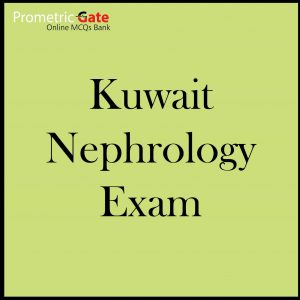Kuwait GP Exam Materials 2024
(8000 MCQs with explanations)
Is an huge study materials more than 8000 new MCQs (with explanation for each question) for those preparing for MOH Exam – KUWAIT (Ministry of Health) for general practitioner include all of the following :
– Cardiology system
– respiratory System
– GIT System
– Neurology system
– Nephrology system
– endocrine system
– Rheumatology system
– Psychiatry
– Dermatology
– Pediatric Section
– Obs. and Gynecology section
– General Surgery Section
– Ophthalmology
– ENT
– Orthopedic
– Family Medicine Section
– Preventive Medicine
-The last new 30 exams (3000 new MCQs).
NOTES !!!
– Do Not miss ! weekly updated questions,
– All questions are corrected by specialist doctor
– No need to study other sources !
– Enough to pass easily
– The materials are suitable for kuwait exam only !! beware !
– 100 % success rate
—————————————————————————————————————————————————————————————————————————
Questions samples :
Question sample 1
A 65-year-old man with no significant past medical history is admitted to the Emergency Department. His ECG is consistent with an anterior myocardial infarction. Unfortunately he develops cardiac arrest shortly after arriving in the department. What is the most common cause of death in patients
following a myocardial infarction?
A. Pulmonary embolism
B. Cardiogenic shock
C. Papillary muscle rupture
D. Ventricular fibrillation **
E. Complete heart block
Myocardial infarction:
Complications
Patients are at risk of a number of immediate, early and late complications following a myocardial infarction (MI).
Cardiac arrest
This most commonly occurs due to patients developing and is the most common cause of death following a MI.
Patients are managed as per the ALS protocol with defibrillation.
Cardiogenic shock
If a large part of the ventricular myocardium is damaged in the infarction the ejection fraction of the heart may decrease to the point that the patient develops cardiogenic shock. This is difficult to treat.
Other causes of cardiogenic shock include the ‘mechanical’ complications such as left ventricular free wall rupture as listed below. Patients may require inotropic support and/or an intra-aortic balloon pump.
Chronic heart failure
As described above, if the patient survives the acute phase their ventricular myocardium may be dysfunctional resulting in chronic heart failure. Loop diuretics such as furosemide will decrease fluid overload. Both ACEinhibitors and beta-blockers have been shown to improve the long-term
prognosis of patients with chronic heart failure.
Tachyarrhythmias
Ventricular fibrillation, as mentioned above, is the most common cause of death following a MI.
Other common arrhythmias including ventricular tachycardia.
Bradyarrhythmias
Atrioventricular block is more common following inferior myocardial infarctions.
Pericarditis
Pericarditis in the first 48 hours following a transmural MI is common (c. 10% of patients). The pain is typical for pericarditis (worse on lying flat etc), a pericardial rub may be heard and a pericardial effusion may be demonstrated with an echocardiogram.
Dressler’s syndrome tends to occur around 2-6 weeks following a MI. The underlying pathophysiology is thought to be an autoimmune reaction against antigenic proteins formed as the myocardium recovers. It is characterized by a combination of fever, pleuritic pain, pericardial effusion and a raised ESR. It is treated with NSAIDs.
Left ventricular aneurysm
The ischaemic damage sustained may weaken the myocardium resulting in aneurysm formation. This is typically associated with persistent ST elevation and left ventricular failure. Thrombus may form within the aneurysm increasing the risk of stroke. Patients are therefore anticoagulated.
Left ventricular free wall rupture
This is seen in around 3% of MIs and occurs around 1-2 weeks afterwards. Patients present with acute heart failure secondary to cardiac tamponade (raised JVP, pulsus paradoxus, diminished heart sounds). Urgent pericardiocentesis and thoracotomy are required.
Ventricular septal defect
Rupture of the interventricular septum usually occurs in the first week and is seen in around 1-2% of patients.
Features: acute heart failure associated with a pan-systolic murmur. An echocardiogram is diagnostic and will exclude acute mitral regurgitation which presents in a similar fashion. Urgent surgical correction is needed.
Acute mitral regurgitation
More common with infero-posterior infarction and may be due to ischaemia or rupture of the papillary muscle. An early-to-mid systolic murmur is typically heard. Patients are treated with vasodilator therapy but often require emergency surgical repair.
Question sample 2
A 40-year-old man complains of widespread pruritus for the past two weeks. The itching is particularly bad at night. He has no history of note and works in the local car factory. On examination he has noted to have a number of linear erythematous lesions in between his fingers. What is the most likely diagnosis?
A. Polyurethane dermatitis
B. Fibreglass exposure
C. Cimex lectularius infestation (Bed-bugs)
D. Scabies **
E. Langerhans cell histiocytosis
Scabies
Scabies is caused by the mite Sarcoptes scabiei and is spread by prolonged skin contact. It typically affects children and young adults.
The scabies mite burrows into the skin, laying its eggs in the stratum corneum. The intense pruritus associatedwith scabies is due to a delayed type IV hypersensitivity reaction to mites/eggs which occurs about 30 days after the initial infection.
Features
??widespread pruritus
??linear burrows on the side of fingers, interdigital webs and flexor aspects of the wrist
??in infants the face and scalp may also be affected
??secondary features are seen due to scratching: excoriation, infection
Management
??permethrin 5% is first-line
??malathion 0.5% is second-line
??give appropriate guidance on use (see below)
??pruritus persists for up to 4-6 weeks post eradication
Patient guidance on treatment (from Clinical Knowledge Summaries)
??avoid close physical contact with others until treatment is complete
??all household and close physical contacts should be treated at the same time, even if
asymptomatic
??launder, iron or tumble dry clothing, bedding, towels, etc., on the first day of treatment to kill off mites.
The BNF advises to apply the insecticide to all areas, including the face and scalp, contrary to the manufacturer’s recommendation.
Patients should be given the following instructions:
??apply the insecticide cream or liquid to cool, dry skin
??pay close attention to areas between fingers and toes, under nails, armpit area, creases of the skin such as at the wrist and elbow
??allow to dry and leave on the skin for 8-12 hours for permethrin, or for 24 hours for malathion, before washing off
??reapply if insecticide is removed during the treatment period, e.g. If wash hands, change nappy, etc
??repeat treatment 7 days later
Question sample 3
Vaginal discharge which is fishy in odor and associated with > 20% clue cells on microscopy will not be associated with which of the following:
a) Due to Gardnerella vaginalis overgrowth
b) Can be treated with metronidazole or clindamycin
c) May see hyphae or spores with addition of KOH
d) Vaginal pH is higher than 4.5
e) Is rarely associated with inflamed or itchy vulva
The correct answer is c)
Explanation:
Bacterial vaginosis (BV) shows clue cells on a wet mount (which are epithelial cells of the vagina that get their distinctive stippled appearance by being covered with bacteria). Gardnerella vaginalis has been reported to occur in up to 100% of women with signs and symptoms of BV and in up to 70% of women with no signs or symptoms of BV. Vaginal odor is the most common, and often initial, symptom of bacterial vaginosis. Increased vaginal discharge is typically mild to moderate. Vulvar irritation is less common. Dysuria or dyspareunia occur rarely.
The normal vaginal pH is 3.8 to 4.5. Bacterial vaginosis, trichomoniasis, and atrophic vaginitis often cause a vaginal pH higher than 4.5.
Antibiotics are the mainstay of therapy for bacterial vaginosis. Medications include metronidazole, clindamycin oral or vaginal suppositories, and metronidazole vaginal gel. Asymptomatic women with Gardnerella vaginalis colonization do not need treatment.
→ Candida infection would present as thick, white, cottage cheese-like, non-odorous discharge. Diagnostic exam would show the yeast (hyphae and pseudo spores of Candida are visible) on the KOH prep.
Question sample 4
A 3-week-old white male presents with a history of several days of projectile vomiting after feeding, and documented weight loss despite a good appetite. There is a questionable history of a paternal uncle having surgery for a similar problem when he was an infant. Which one of the following findings is a characteristic sign of this disease?
a) Hypochloremic alkalosis
b) Pneumonia
c) Generalized abdominal distension
d) Currant jelly stool
e) Direct hyperbilirubinemia
The correct answer is a)
Explanation:
Hypertrophic pyloric stenosis is the most likely diagnosis in this case. If it is allowed to progress untreated, there may be signs of malnutrition, constipation, oliguria, and profound hypochloremic metabolic alkalosis (choice A). The latter is a characteristic sign of pyloric obstruction. As the child vomits chloride and hydrogen-rich gastric contents, hypochloremic
alkalosis sets in.
Pneumonia (choice B) is not a common problem with pylori stenosis, as it can be with
congenital tracheoesophageal fistulae for example.
After feeding, there may be a visible peristaltic wave that progresses across the abdomen.
However, since the point of obstruction is proximal to the small and large intestines and affected infants lose weight, the abdomen is usually flat rather than distended (choice C), especially in the malnourished infant.
Currant jelly stool (choice D) is a common clinical manifestation of intussusception.
Mild jaundice with elevated indirect bilirubin (not direct, as stated in choice E) is seen in about 5% of infants with pyloric stenosis, but is not a characteristic sign.
Question sample 5
In comparing experimental studies with observational studies, which of the following statements is false?
a) The Hawthorne studies are an example of an experimental study
b) An observational study uses a survey to collect observations and perform statistical analysis
c) An experimental study does not involve experimental manipulation
d) An observational study does not involve experimental manipulation
The correct answer is c)
Explanation:
In both types of studies, the effect of differences of an independent variable (or variables) on the behavior of the dependent variable are observed. The difference between the two types is in how the study is actually conducted.
An experimental study involves taking measurements of the system under study, manipulating the system, and then taking additional measurements using the same procedure to determine if the manipulation may have modified the values of the measurements.
In contrast, an observational study does not involve experimental manipulation. Instead data are gathered and correlations between predictors and the response are investigated.
An example of an experimental study is the famous Hawthorne studies which attempted to test changes to the working environment at the Hawthorne plant of the Western Electric Company. The researchers were interested in whether increased illumination would increase the productivity of the assembly line workers. The researchers first measured productivity in the plant then modified the illumination in an area of the plant to see if changes in illumination would affect productivity. As it turns out, productivity improved under all the experimental conditions (see Hawthorne effect).
An example of an observational study is a study which explores the correlation between smoking and lung cancer.
This type of study typically uses a survey to collect observations about the area of interest and then perform statistical analysis. In this case, the researchers would collect observations of both smokers and non-smokers, perhaps through a case-control study, and then look at the number of cases of lung cancer in each group.





Neyaj Ansari –
It’s good and clinical parts r well explained
Neyaj Ansari –
Good and well explain